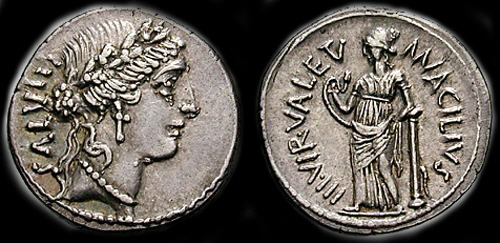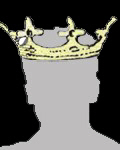








Designed by Nigel G Wilcox





The Paragon Of Metal Detecting
& Archaeology
& Archaeology
Powered By Sispro1
Denarius
For Reference ONLY
Everything For The Detectorist
Roman Denarius BC - Currency Numismatics,
**


Denarius



Man Acilius Glabrio 49 BC
Consul at Rome during A.D. 91, with Trajan. He belonged to one of the noblest families of Rome, no fewer than nine of his name having held the consular office, the first being that Acilius Glabrio who was consul in A.U.C. 563 (191 B.C.), conquered the Macedonians at the battle of Thermopylae, and in whose honour the Temple of Piety, now the church of S. Nicola in Carcere, was erected. The family attained great wealth and power, and their gardens, in the early imperial period, covered the whole of what is now the Pincian Hill. The subject of the present memoir was put to death by Domitian in the year 95. Suetonius (Domit., c. x) tells us that the emperor caused several senators and ex-consuls to be executed on the charge of conspiring against the empire -- quasi molitores rerum novarum , "as contrivers of novelty" -- and among them he names "Acilius Glabrio, who had previously been banished from Rome ". The charge of "contriving novelties" seems in this particular case -- not, however, in the others which are mentioned with it -- to denote adhesion to the Christian religion. Dio Cassius (lxvii, 12, 14) tells us, as also does Juvenal (Sat., iv, 94), that, during his consulship and before his banishment, Glabrio was forced by Domitian to fight with a lion and two bears in the amphitheatre adjoining the emperor's villa at Albanum. This amphitheatre still exists, and was excavated in 1887. It is partly hollowed out of the side of the mountain, and commands a remarkable view. Xiphilinus, speaking of the executions of 95, says that some members of the imperial family and other persons of importance were condemned for atheism, as having embraced "the customs and persuasions of the Jews ", that is, of course, the Christian Faith. Among these he mentions Clemens and Domitilla, of whose Christianity there is no doubt. Glabrio was involved in this trial and suffered under this indictment, so that we could have little doubt that he too was a Christian, even if we had not the archaeological evidence of which we shall now speak.
Glabrio was put to death in his place of exile, concerning the location of which we have no knowledge. But his body was brought to Rome, and buried on the Via Salaria, in the catacomb of Priscilla. Here the crypt, in which he with many of his family and dependents was laid to rest, was discovered in 1888. Henceforth there can be no doubt of his religion, or concerning the cause of his execution. Unfortunately, the crypt had been wrecked by treasure-seekers, the date of whose vandalistic action can be fixed as the time of Clement VIII (1667-70). The hypogaeum was of very unusual form, consisting of a single large ambulacrum or "cryptoporticus in gamma", that is turned at right angles with its own staircase. The places for tombs were all large "arcosolia", or niches for sarcophagi; there was not a single loculus of the usual cemeterial pattern in the walls. At the end of the longer arm of the gamma a passage was opened into a large hall, nine yards by four and a half, barrel-vaulted and with a square "lucernarium", which had apparently originally been a cistern for water. It had contained an altar, raised over a tomb, with spiral columns of giallo antico, and was at one time beautifully decorated, but had been entirely wrecked. In it, however, were found fragments of a marble sarcophagus, with the inscription ACILIO GLABRIO . . . FILIO still legible. Other fragments were afterwards discovered, which placed it beyond doubt hat here was a burying-place of the Acilian family, round one of their race who apparently had been a martyr. The lettering of the chief inscription being of the time of Domitian or thereabouts, and the fact that the hypogaeum itself belongs to the earliest age of Christianity, is sufficient to enable us to feel certain that we have here the tomb of the famous consul. The date and the from the place where he suffered are not known.
Consul at Rome during A.D. 91, with Trajan. He belonged to one of the noblest families of Rome, no fewer than nine of his name having held the consular office, the first being that Acilius Glabrio who was consul in A.U.C. 563 (191 B.C.), conquered the Macedonians at the battle of Thermopylae, and in whose honour the Temple of Piety, now the church of S. Nicola in Carcere, was erected. The family attained great wealth and power, and their gardens, in the early imperial period, covered the whole of what is now the Pincian Hill. The subject of the present memoir was put to death by Domitian in the year 95. Suetonius (Domit., c. x) tells us that the emperor caused several senators and ex-consuls to be executed on the charge of conspiring against the empire -- quasi molitores rerum novarum , "as contrivers of novelty" -- and among them he names "Acilius Glabrio, who had previously been banished from Rome ". The charge of "contriving novelties" seems in this particular case -- not, however, in the others which are mentioned with it -- to denote adhesion to the Christian religion. Dio Cassius (lxvii, 12, 14) tells us, as also does Juvenal (Sat., iv, 94), that, during his consulship and before his banishment, Glabrio was forced by Domitian to fight with a lion and two bears in the amphitheatre adjoining the emperor's villa at Albanum. This amphitheatre still exists, and was excavated in 1887. It is partly hollowed out of the side of the mountain, and commands a remarkable view. Xiphilinus, speaking of the executions of 95, says that some members of the imperial family and other persons of importance were condemned for atheism, as having embraced "the customs and persuasions of the Jews ", that is, of course, the Christian Faith. Among these he mentions Clemens and Domitilla, of whose Christianity there is no doubt. Glabrio was involved in this trial and suffered under this indictment, so that we could have little doubt that he too was a Christian, even if we had not the archaeological evidence of which we shall now speak.
Glabrio was put to death in his place of exile, concerning the location of which we have no knowledge. But his body was brought to Rome, and buried on the Via Salaria, in the catacomb of Priscilla. Here the crypt, in which he with many of his family and dependents was laid to rest, was discovered in 1888. Henceforth there can be no doubt of his religion, or concerning the cause of his execution. Unfortunately, the crypt had been wrecked by treasure-seekers, the date of whose vandalistic action can be fixed as the time of Clement VIII (1667-70). The hypogaeum was of very unusual form, consisting of a single large ambulacrum or "cryptoporticus in gamma", that is turned at right angles with its own staircase. The places for tombs were all large "arcosolia", or niches for sarcophagi; there was not a single loculus of the usual cemeterial pattern in the walls. At the end of the longer arm of the gamma a passage was opened into a large hall, nine yards by four and a half, barrel-vaulted and with a square "lucernarium", which had apparently originally been a cistern for water. It had contained an altar, raised over a tomb, with spiral columns of giallo antico, and was at one time beautifully decorated, but had been entirely wrecked. In it, however, were found fragments of a marble sarcophagus, with the inscription ACILIO GLABRIO . . . FILIO still legible. Other fragments were afterwards discovered, which placed it beyond doubt hat here was a burying-place of the Acilian family, round one of their race who apparently had been a martyr. The lettering of the chief inscription being of the time of Domitian or thereabouts, and the fact that the hypogaeum itself belongs to the earliest age of Christianity, is sufficient to enable us to feel certain that we have here the tomb of the famous consul. The date and the from the place where he suffered are not known.
Roman Emperor Timeline
Roman Menu
Copyright © All Rights Reserved by Nigel G Wilcox · · E-Mail: ngwilcox100@gmail.com
Pages
Main Coin Menu

VIEW ALL
Member NCMD
R.B.C. Menu
Information Data

























